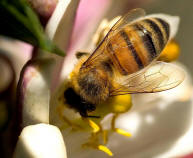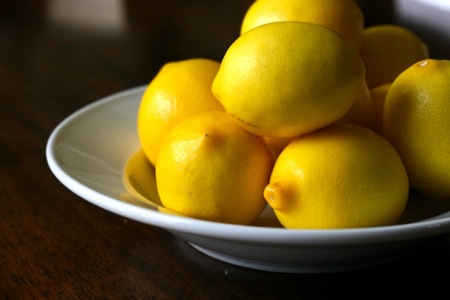Interactions
Even though Citrus limon is a free-living organism it does have important relationships with other organisms. One of these important relationships is a mutualistic relationship with mycorrhizae. A mutualistic relationship means that both organisms are benefiting from the relationship. Mycorrhizae is a fungi that grows in or outside of the plant's roots. This fungus assists in nutrient uptake which the lemon tree benefits from and in return the lemon tree gives the fungi sugars/carbohydrates.
 Another important mutualistic relationship that Citrus limon
partakes in is with pollinating insects. In order for the
lemon tree to reproduce pollination must occur and insects like
the
Rusty-Patched Bumble Bee and the
European Honey Bee help the tree pollinate. In
return the insects get food (nectar) from the flower.
Another important mutualistic relationship that Citrus limon
partakes in is with pollinating insects. In order for the
lemon tree to reproduce pollination must occur and insects like
the
Rusty-Patched Bumble Bee and the
European Honey Bee help the tree pollinate. In
return the insects get food (nectar) from the flower.
Citrus limon does not only have mutualistic relationships but also has parasitic relationships. A parasitic relationship is when one organism benefits while the other organism is harmed. The lemon tree can be affected by many different types of parasitic fungi and diseases. There is a wide range of damage that can be caused. Often times the fruit is the part that is affected negatively or harmed. The fungi and diseases usually do not kill the lemons however they do make the lemons unmarketable.
Humans also have an important relationship with lemons. This
relationship can be classified as commensalism. This means
that one organism benefits while the other organism neither
benefits or is harmed. Lemons play an important role in
everyday life for humans. Lemons are not a sustainable
food source for humans because they do not contain protein, fat
and very little carbohydrates. However, the lemon industry
provided jobs for people whether it is picking the lemons,
selling the lemons, or making lemon products. They also
used for cooking, cleaning, preserving food, making lemonade,
decoration and
much more. So humans may not use lemons as a food source
but they do benefit us in other ways.
important role in
everyday life for humans. Lemons are not a sustainable
food source for humans because they do not contain protein, fat
and very little carbohydrates. However, the lemon industry
provided jobs for people whether it is picking the lemons,
selling the lemons, or making lemon products. They also
used for cooking, cleaning, preserving food, making lemonade,
decoration and
much more. So humans may not use lemons as a food source
but they do benefit us in other ways.
